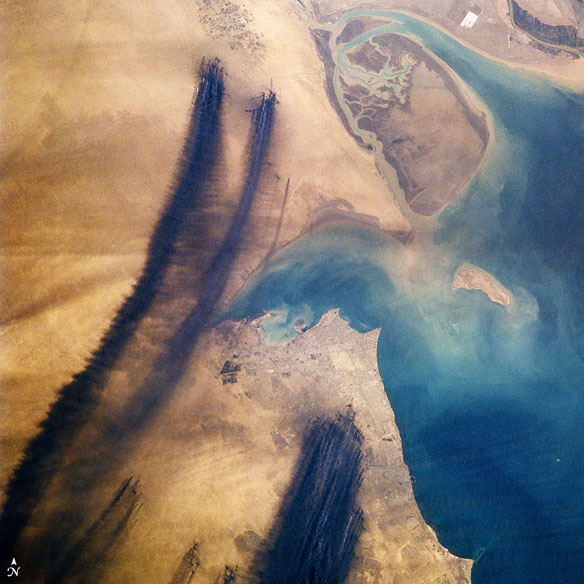
In 1991, Landsat captured the devastating environmental consequences of war. As Iraqi forces withdrew from Kuwait, they set fire to over 650 oil wells and damaged almost 75 more, which then spewed crude oil across the desert and into the Persian Gulf. Captions and Photo source: NASA / Earth Observatory
By Greenpeace;
Today, 6th November, marks the International Day for Preventing the Exploitation of the Environment in War and Armed Conflict.
In the havoc and destruction spread by war, damage to the environment is almost always regarded as a necessary price to be paid. But cleaning up the environmental consequences of war is a tough, often impossible, task. Damage to the environment in times of armed conflict can impair ecosystems and natural resources long after the period of conflict, often extending beyond the limits of national territories and the present generation.
Often during conflict, the environment itself has been used as a weapon of war, of mass destruction. Soils have been poisoned, water wells polluted, crops torched, forests cut down, all to achieve political and military goals: subdue resistance, destroy people’s livelihood and drive them away from their homes.
During the Vietnam War, nearly 72 million litres of ‘agent orange’, a combination of deadly chemicals, were sprayed over the country’s forests, stripping huge areas of all vegetation. Even today it is impossible to grow anything in some of these areas.
During the 1991 gulf war, an estimated 1500m litres of oil were released into the gulf waters causing the world’s largest oil spill. Much of the oil washed ashore and contaminated over 700km of coastline. At least 30,000 marine birds were estimated to have perished due to oil exposure. Fire set to more than 600 oils wells in Kuwait’s oil fields took up to eight months to extinguish, leading to immediate respiratory problems with local populations.
Greenpeace ship, the MV Greenpeace, sailed into the gulf immediately after the war, documenting and raising awareness to the damage. Committed teams from Greenpeace went to the Balkans in 1992 and then back to Iraq in 2003, to inspect a nuclear plant that was left unsecured and looted after the fall of the regime in the second Gulf war.
15 years after the MV Greenpeace sailed into the oil polluted water of the gulf, it was Greenpeace’s ship Rainbow Warrior that sailed to Lebanon to document and help with the clean up of an oil spill created by the bombing of fuel tanks at the Jiyeh power station outside of Beirut, during the war in the summer of 2006. The bombing caused the leakage of 12,000 to 15,000 tons of fuel into the Mediterranean Sea. Because of the on-going conflict clean up efforts started only five weeks later, by then the oil contamination had spread over 150km of Lebanese coastline.
The problem is not only that war destroys the environment. The problem is also that exploitation of natural resources triggers and fuels further conflict, which also destroys the environment. Conflicts involving natural resources are twice as more likely to relapse. This is a vicious cycle. According to the UN Environment Programme , over the past sixty years at least 40% of all intrastate conflicts had a link to natural resources. Timber, diamonds, gold, minerals and oil were at the centre of civil wars in Liberia, Angola and the DRC. Other conflicts, such as in the Middle East and Sudan, have involved control of scarce resources such as fertile land and water. Sudan has been in and out of conflict for most of the past fifty years. Many of these conflicts were partly initiated by tension over the use of natural resources. The same resources that were often damaged by conflict. Climate change will further compound water and other resource stresses, not only in Sudan or in the Sahel region, but all over the world.
Back in 1992, governments from all over the world gathering in Rio acknowledged that peace, development and environmental protection are interdependent and indivisible. Sadly, not much has changed. Since 1990 at least eighteen violent conflicts have been fuelled by the exploitation of natural resources. There can be no peace without environmental protection.
We must not allow the environment to remain a silent casualty.
The environment needs strong advocates to speak on its behalf. Join Greenpeace in speaking up against the exploitation of the environment in war and armed conflict. Let us say, loud and clear: by protecting the environment, we are protecting ourselves.
Original Article; Learn More, Greenpeace
The Mekong: Record of the Vietnam War, Science Daily
During the second half of the 20th Century, South-East Asia was the arena of a series of armed conflicts, direct consequences of the Second World War, decolonization and the Cold War, followed by political instability which continued up to the 1990s. The region’s history has left its scars on the environment.Research scientists from the IRD and its partners recently showed the discharge rate of the Mekong has oscillated in close correlation with the major events that had taken place.
Between 1965 and 1975 South-East Asia was the theatre of the heaviest bombing campaigns in human history. One kilogram of artillery wipes out over 12 m² of vegetation cover. The amplitude of the environmental effects of such an attack was appalling: between 8 000 and 40 000 km² are estimated to have been deforested just over this study zone, amounting to 70% of its surface area. Only the extensive changes in land-use and vegetation pattern can explain such variations in discharge of the Mekong. To characterize the effects of these events on the runoff which feeds the river system, the researchers focused on two war zones: one in southern Laos, subjected to heavy bombing, the other in the North of the country, the arena for intensive land-based military operations.









